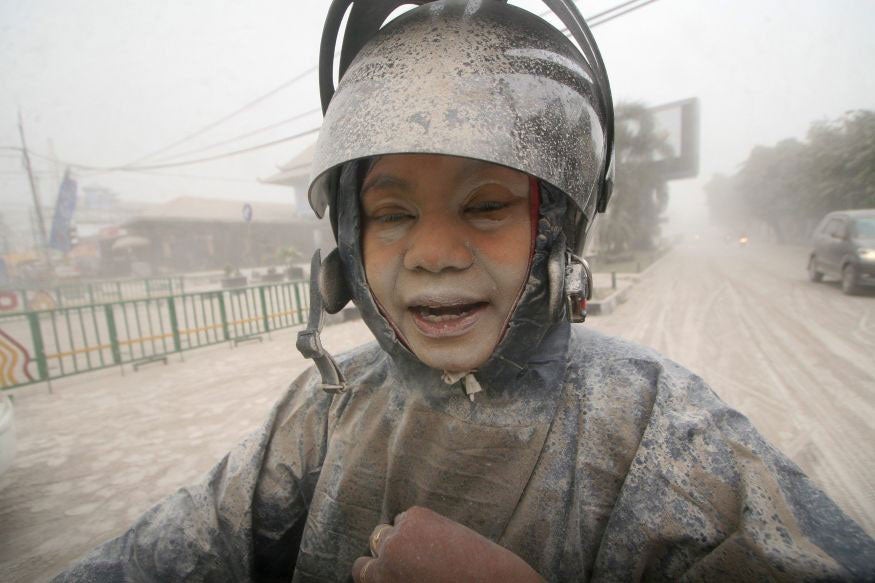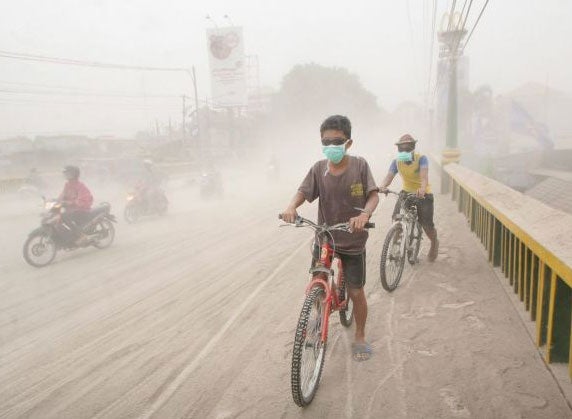Indonesia volcano erupts: 100,000 flee Mount Kelud eruption that could be heard 200km away
Three international airports close as ash cloaks huge area

Your support helps us to tell the story
From reproductive rights to climate change to Big Tech, The Independent is on the ground when the story is developing. Whether it's investigating the financials of Elon Musk's pro-Trump PAC or producing our latest documentary, 'The A Word', which shines a light on the American women fighting for reproductive rights, we know how important it is to parse out the facts from the messaging.
At such a critical moment in US history, we need reporters on the ground. Your donation allows us to keep sending journalists to speak to both sides of the story.
The Independent is trusted by Americans across the entire political spectrum. And unlike many other quality news outlets, we choose not to lock Americans out of our reporting and analysis with paywalls. We believe quality journalism should be available to everyone, paid for by those who can afford it.
Your support makes all the difference.A major volcanic eruption in Indonesia shrouded a large swath of the country's most heavily populated island in ash on Friday, triggering the evacuation of more than 100,000 people and the closure of three international airports after killing two people.
The explosive overnight eruption of Java island's Mount Kelud could be heard up to 200 kilometers (125 miles) away, Indonesia's disaster agency said.
The ash cloud reached 30 kilometers (18 miles) into the atmosphere and fell to earth in towns and cities across the region, including Surabaya, Indonesia's second-largest city, and even farther afield in Yogyakarta, where motorists switched on headlights in daylight.
Kediri, a normally bustling town about 30 kilometers (19 miles) from the mountain, was largely deserted as residents stayed indoors to avoid the choking ash.
"The smell of sulphur and ash hung so thickly in the air that breathing was painful," said Kediri resident Insaf Wibowo.
Some residents were shoveling the ash and grit into sacks to use for the construction of buildings or to fertilise crops. One collector said that middlemen had already told him they would pay up to $56 for a small truck filled with the debris.
Two people were killed when the roofs of their homes collapsed under the weight of the ash and volcanic debris unleashed during the eruption, the disaster agency said.
International airports in Yogyakarta, Solo and Surabaya were closed due to reduced visibility and the dangers posed to aircraft engines by ash, Transport Ministry spokesman Bambang Ervan said. Virgin Australia said it had canceled all its Friday flights to Bali, Phuket, Christmas Island and Cocos Island because of the eruption.
The disaster agency said tremors were still wracking the volcano, but that scientists didn't expect another major eruption. It said all villages within 10 kilometers (6 miles) of Kelud — more than 100,000 people — had been evacuated to temporary shelters, but that elsewhere villagers had returned to their homes to begin cleaning up.
The 1,731-meter-high (5,680-foot-high) Mount Kelud in eastern Java — Indonesia's most densely populated island and home to more than half of the country's 240 million people — has been rumbling for several weeks and was under close observation.

Muhammad Hendrasto, head of Indonesia's volcano monitoring agency, said the mountain erupted violently about 90 minutes after authorities raised its alert status to the highest level. The disaster agency said it had spewed millions of cubic meters of debris into the atmosphere.
Kelud is among about 130 active volcanoes in Indonesia. The archipelagic nation is prone to volcanic eruptions and earthquakes because of its location on the so-called "Ring of Fire" — a series of fault lines stretching from the Western Hemisphere through Japan and Southeast Asia.
Due to the fertile volcanic soil and the shortage of space on Java, hundreds of thousands of people live close to active volcanoes. They are used to the rumblings, but their proximity to the peaks presents difficulties for authorities.
The last major eruption at Kelud was in 1990, when it kicked out searing fumes and lava that killed more than 30 people and injured hundreds. In 1919, a powerful explosion that reportedly could be heard hundreds of kilometers away killed at least 5,160 people.
Earlier this month, Mount Sinabung in North Sumatra province erupted as authorities were allowing thousands of villagers who had been evacuated to return to its slopes, killing 16 people. Sinabung has been erupting for four months, forcing the evacuation of more than 30,000 people.
AP
Subscribe to Independent Premium to bookmark this article
Want to bookmark your favourite articles and stories to read or reference later? Start your Independent Premium subscription today.
Join our commenting forum
Join thought-provoking conversations, follow other Independent readers and see their replies
Comments